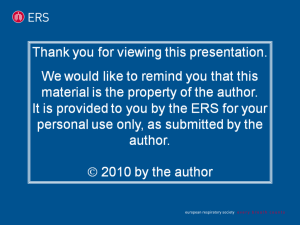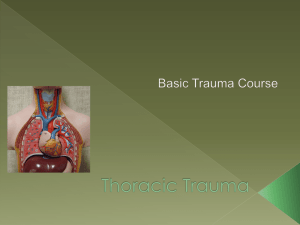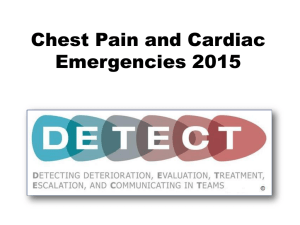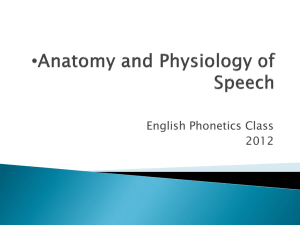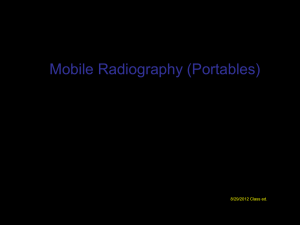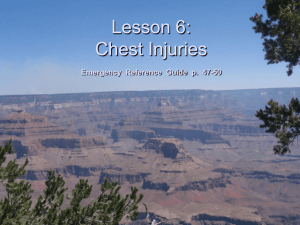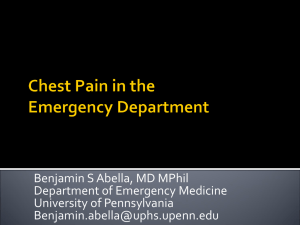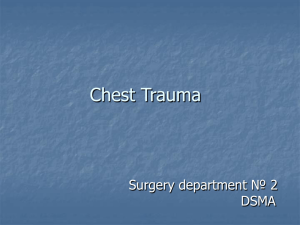Night Float Module Interpretation of Chest Radiographs
advertisement
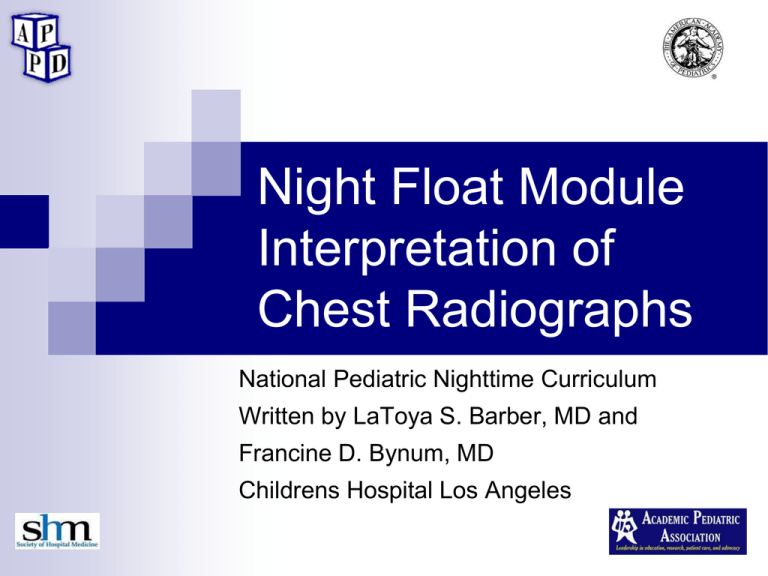
Night Float Module Interpretation of Chest Radiographs National Pediatric Nighttime Curriculum Written by LaToya S. Barber, MD and Francine D. Bynum, MD Childrens Hospital Los Angeles Goals And Objectives Develop a comprehensive approach to reading chest x-rays Identify the following conditions on chest x-ray pneumonia and its complications pneumothorax atelectasis Describe two radiographic features for both pneumonia and pneumothorax Case # 1 4 year old male with 2 weeks of cough, rhinorrhea and a one day history of tactile fevers, brought to the emergency department for increased WOB and hypoxia. Vitals Temp 38.8 HR 130 RR 40 BP 101/50 Pulse Ox 92% What are the top three diagnoses on your differential? Is it appropriate to obtain a Chest X-ray in this situation? What factors would support obtaining a Chest X-ray? What factors would deter you from obtaining a Chest X-ray? Case # 2 12 year old tall thin male is admitted overnight for monitoring after having a complicated eye surgery. 3 hours into your shift you receive a consult from Ophthalmology to evaluate the patient He is complaining of a sharp, persistent chest pain and shortness of breath. On exam, you note long fingers and thin skin What are the top three diagnoses on your differential? Is a Chest X-ray Indicated? Should it be ordered routine or stat? Chest Radiography Proven and useful tool for the evaluation of… The most common cause for obtaining a Chest X-ray at night is an Acute Respiratory illness Definition Airways, lungs, pleura, and chest wall Heart, pulmonary vessels, and mediastinum Most common type is posteroanterior (PA) Anteroposterior (AP) and lateral films also common “One or more of the following: cough, sputum production, chest pain, or dyspnea (with or without fever) Determination of need for Chest X-ray or other imaging depends on other history and physical exam findings Components of a PA Chest X-Ray Inclusive of following structures: – Both lung apices – Both costophrenic angles – Mid-thoracic vertebral bodies, centered on film – Left retro-cardiac pulmonary vessels PA Chest X-Ray: Anatomic Correlation Lateral Chest X-ray: Anatomic Correlation Approach to Interpretation of Chest X-ray: “Top to Bottom” AAirway: Evaluate Trachea and thoracic inlet (should be centrally located) LLungs: Look at expansion and inspiratory effort (should be able to count 11 ribs) Look for opacities, consolidation, fissures, fluid, air bronchograms Compare the right and left lung HHeart and Large Vessels: Evaluate heart size and shape Evaluate the location and prominence of vessels DDiaphragm: Look at elevation bilaterally Evaluate for free air underneath BBones: Look for fractures and deformities Evaluate bone density UUpper Abdomen: Look for stomach bubble Evaluate liver size Lobes and Fissures LUL LUL RUL RUL RML RML RLL LLL RLL LLL Left Lateral View Right Lateral View http://www.wikiradiography.com/page/Chest+Radiographic+Anatomy Case # 1 4 year old male with 2 weeks of cough, rhinorrhea and a one day history of tactile fevers, brought to the emergency department for increased WOB and hypoxia. Vitals Temp 38.8 HR 130 RR 40 BP 101/50 Pulse Ox 92% Lobar consolidation What are the top three diagnoses on your differential? Is it appropriate to obtain a Chest Xray in this situation? What factors would support obtaining a Chest X-ray? What factors would deter you from obtaining a Chest X-ray? What Do You See? http://radiology.rsna.org/content/210/2/ 339/F1.large.jpg Radiographic Findings in Pneumonia Air bronchograms = most correlative New or worsening lung opacities Asymmetric focal findings Interstitial disease, especially in viral or atypical pneumonia Cavities, indicative of necrotizing pneumonia Air Bronchograms Indicates airspace disease Visualized when an air-filled bronchus is surrounded by opacified alveoli Can be seen with : pulmonary consolidation pulmonary edema non-obstructive atelectasis severe interstitial disease neoplasm pulmonary infarction normal expiration http://medicalfinals.co.uk/RadiologyQuizFebruary2007.html Viral Pneumonia Atypical Pneumonia http://radiographics.rsna.org/content/22/ suppl_1/S137/F25.large.jpg http://radiographics.rsna.org/content/21/1/121/ F10.expansion Atelectasis Volume loss with displacement of fissures White out of lobe or lung If large volume of lung involved, may get elevation of hemidiaphragm and displacement of mediastinal structures Radiographic findings resolve within hours to days http://www.ajronline.org/content/vol183/issue6/i mages/large/12_03_0142_02A.jpeg Complications of Pneumonia on Chest X-ray Pleural Effusion •Appears as white density within lung field • If not loculated, will layer out on lateral decubitus film http://pediatrics.aappublications.org/cgi/conte nt/full/122/4/e945/F1 Empyema •Appears as solid white consolidate that blunts the costophrenic angle •May not layer out on lateral decubitus http://www.ajtmh.org/cgi/content/full/ 75/6/1234/F1 Lateral Decubitus Assess volume of pleural effusion Determine if effusion is mobile or loculated http://www.med-ed.virginia.edu/courses/rad/cxr/technique4chest.html Case # 2 12 year old tall thin male admitted overnight for monitoring after having a complicated eye surgery. 3 Hours into your shift you receive a consult from Ophthalmology to evaluated the patient He is complaining of a sharp, persistent chest pain and shortness of breath. You note on exam long fingers and thin skin What are the top three diagnoses on your differential? Is a Chest X-ray Indicated? What Do You See? Should it be ordered routine or stat? http://bjr.birjournals.org/cgi/content/ full/74/877/89/F13 Pneumothorax on Chest X-ray Consider if the X-ray is supine or erect Supine Air tends to accumulate in the posterior chest wall May appear near diaphragm first Erect Air accumulates near the apices Take Home Points A chest x-ray is a simple test that can be used in the diagnosis of many diseases. Pneumonia is a clinical diagnosis. Chest x-ray can be a useful tool to support the diagnosis and identify complications. When pneumothorax is suspected, chest x-ray should be obtained to determine its size and location and help guide management decisions. Thank You! Please tell us what you like and dislike about this module! Your anonymous feedback will help us continue to improve this curriculum. https://www.surveymonkey.com/s/Feedba ck-on-Modules References Swischuk,E. Leonard. Emergency Imaging of the Acutely Ill or Injured Child. Lippencot Williams and Wilkins: Philidelphia, PA. 2000. Pages 71-88 Behrman, Kliegman, Jenson. Nelsons Textbook of Pediatrics 17th edition. Atelectasis pp 1459-1461 Koumbourlis, AC. Albert Einstein College of Medicine, and Division of Pulmonary Medicine. Schneider Childrens Hospital, New Hyde Park, New York. Scoliosis and the Respiratory System. Paediatric Respiratory Review. 2006. Jun: 7(2):152-60. Epub 2006. Jun 2 Schechter, MS. Airway Clearance Applications in infants and children. Respiratory Care. 2007. October: 52(10):1382-90 Ilrena M. Tocino, M.D. Pneumothorax in the Supine Patient: Radiographic Anatomy. Radiographics Tocino 5 (4): 557. http://radiographics.rsnajnls.org/cgi/content/abstract/5/4/557 . Byung Gil Choi, MD. Seog Hee Park, MD. Eun Hee Yun, MD. Kyung Ok Chae, MD. Kyung Sub Shinn, MD Pneumothorax Size:Correlation of Supine Anteroposterior with Erect Posteroanterior Chest Radiographs. Radiology 1998; 209:567-569. http://radiology.rsnajnls.org/cgi/reprint/209/2/567 Dick, Elizabeth, specialist registrar in radiology, North Thames Deanery. Chest Xrays Made Easy. studentBMJ 2000;08:303-346 September ISSN 0966-6494. http://lifeinthefastlane.com/education/investigations-tests/cxr-normal/ http://radiopaedia.org/articles/air_bronchogram http://en.wikipedia.org/wiki/Chest_radiograph Durbin, WJ and Stille, C Pneumonia. Pediatr. Rev. 2008; 29; 147-160 Zaoutis, LB, Chiang, VW. Comprehensive Pediatric Hospital Medicine, 2007. Philadelphia, Elsevier. Kliegman, RM, Behrman, RE, Jenson, HB, Stanton, BF. Nelson Textbook of Pediatrics, 2007. Philadelphia, Elsevier. References ACR Practice Guideline for the Performance of Pediatric and Adult Chest Radiography. Revised 2006. http://www.acr.org/guidelines Acute Respiratory Illness. ACR Appropriateness Criteria. Revised 2006. http://www.acr.org/guidelines Fever Without Source—Child. ACR Appropriateness Criteria. Revised 2006. Http://www.acr.org/guidelines Congestive Heart Failure. ACR Appropriateness Criteria. Revised 2006. Http://www.acr.org/guidelines Durbin, WJ and Stille, C Pneumonia. Pediatr. Rev. 2008; 29; 147-160 Zaoutis, LB, Chiang, VW. Comprehensive Pediatric Hospital Medicine, 2007. Philadelphia, Elsevier. Kliegman, RM, Behrman, RE, Jenson, HB, Stanton, BF. Nelson Textbook of Pediatrics, 2007. Philadelphia, Elsevier. ACR Practice Guideline for the Performance of Pediatric and Adult Chest Radiography. Revised 2006. http://www.acr.org/guidelines Acute Respiratory Illness. ACR Appropriateness Criteria. Revised 2006. http://www.acr.org/guidelines Fever Without Source—Child. ACR Appropriateness Criteria. Revised 2006. Http://www.acr.org/guidelines Congestive Heart Failure. ACR Appropriateness Criteria. Revised 2006. Http://www.acr.org/guidelines http://www.wikiradiography.com/page/The+Supine+Pneumothorax http://www.wikiradiography.com/page/Chest+Radiographic+Anatomy Pediatric Hospital Medicine Education Resource Page: http://sites.google.com/site/phmeducationresources/home
